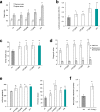Purification and identification of a polysaccharide from medicinal mushroom Amauroderma rude with immunomodulatory activity and inhibitory effect on tumor growth
- PMID: 26219260
- PMCID: PMC4627345
- DOI: 10.18632/oncotarget.4397
Purification and identification of a polysaccharide from medicinal mushroom Amauroderma rude with immunomodulatory activity and inhibitory effect on tumor growth
Abstract
Medicinal mushrooms in recent years have been the subject of many experiments searching for anticancer properties. We previously screened thirteen mushrooms for their potential in inhibiting tumor growth, and found that the water extract of Amauroderma rude exerted the highest activity. Previous studies have shown that the polysaccharides contained in the water extract were responsible for the anticancer properties. This study was designed to explore the potential effects of the polysaccharides on immune regulation and tumor growth. Using the crude Amauroderma rude extract, in vitro experiments showed that the capacities of spleen lymphocytes, macrophages, and natural killer cells were all increased. In vivo experiments showed that the extract increased macrophage metabolism, lymphocyte proliferation, and antibody production. In addition, the partially purified product stimulated the secretion of cytokines in vitro, and in vivo. Overall, the extract decreased tumor growth rates. Lastly, the active compound was purified and identified as polysaccharide F212. Most importantly, the purified polysaccharide had the highest activity in increasing lymphocyte proliferation. In summary, this molecule may serve as a lead compound for drug development.
Keywords: amauroderma; cytokine; herbal medicine; medicinal mushroom; tumor growth.
Figures







Similar articles
-
Ergosterol purified from medicinal mushroom Amauroderma rude inhibits cancer growth in vitro and in vivo by up-regulating multiple tumor suppressors.Oncotarget. 2015 Jul 10;6(19):17832-46. doi: 10.18632/oncotarget.4026. Oncotarget. 2015. PMID: 26098777 Free PMC article.
-
Anticancer activity of Amauroderma rude.PLoS One. 2013 Jun 20;8(6):e66504. doi: 10.1371/journal.pone.0066504. Print 2013. PLoS One. 2013. PMID: 23840494 Free PMC article.
-
Antitumor and immunomodulatory activity of polysaccharides from the roots of Actinidia eriantha.J Ethnopharmacol. 2009 Sep 7;125(2):310-7. doi: 10.1016/j.jep.2009.06.015. Epub 2009 Jun 25. J Ethnopharmacol. 2009. PMID: 19559777
-
Biologically active polysaccharide from edible mushrooms: A review.Int J Biol Macromol. 2021 Mar 1;172:408-417. doi: 10.1016/j.ijbiomac.2021.01.081. Epub 2021 Jan 16. Int J Biol Macromol. 2021. PMID: 33465360 Review.
-
Current findings, future trends, and unsolved problems in studies of medicinal mushrooms.Appl Microbiol Biotechnol. 2011 Mar;89(5):1323-32. doi: 10.1007/s00253-010-3067-4. Epub 2010 Dec 29. Appl Microbiol Biotechnol. 2011. PMID: 21190105 Review.
Cited by
-
Anticancer Activity of Cynomorium coccineum.Cancers (Basel). 2018 Sep 26;10(10):354. doi: 10.3390/cancers10100354. Cancers (Basel). 2018. PMID: 30261584 Free PMC article.
-
Hypouricemic Effects of Ganoderma applanatum in Hyperuricemia Mice through OAT1 and GLUT9.Front Pharmacol. 2018 Jan 15;8:996. doi: 10.3389/fphar.2017.00996. eCollection 2017. Front Pharmacol. 2018. PMID: 29379442 Free PMC article.
-
Lentinan dose dependence between immunoprophylaxis and promotion of the murine liver cancer.Oncotarget. 2017 Aug 1;8(56):95152-95162. doi: 10.18632/oncotarget.19808. eCollection 2017 Nov 10. Oncotarget. 2017. PMID: 29221118 Free PMC article.
-
Characterizing novel anti-oncogenic triterpenoids from ganoderma.Cell Cycle. 2018;17(5):527-528. doi: 10.1080/15384101.2017.1315493. Cell Cycle. 2018. PMID: 28402700 Free PMC article. No abstract available.
-
Ergosterol peroxide activates Foxo3-mediated cell death signaling by inhibiting AKT and c-Myc in human hepatocellular carcinoma cells.Oncotarget. 2016 Jun 7;7(23):33948-59. doi: 10.18632/oncotarget.8608. Oncotarget. 2016. PMID: 27058618 Free PMC article.
References
-
- Vo TS, Ngo DH, Kang KH, Jung WK, Kim SK. The beneficial properties of marine polysaccharides in alleviation of allergic responses. Mol Nutr Food Res. 2015;59:129–138. - PubMed
Publication types
MeSH terms
Substances
LinkOut - more resources
Full Text Sources
Other Literature Sources

